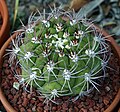Description
Gymnocalycium saglionis is known to grow very slowly, and grow best in warm and part shady conditions, but tolerate extremely bright situations although they are likely to suffer from sun scorch or stunted growth if over exposed to direct sunlight during the hottest part of the day in summer.
The body can range from dull-green or blue-green, almost cylindrical more or less flattened up to 40 cm (16 in) in diameter, up to 90 cm (35 in) tall. Spines can grown to 3–4 cm (1.2–1.6 in) long, colors varies from yellowish-brown, reddish or white becoming grey with time which contrast well against the green body, 1−3 centrals and 10−15 radials bent against the stem.
Spines become bright red when wet.
Flowers 3.6 cm (1.4 in) long, white or reddish, often more than one simultaneously. Fruits globular, reddish or dark pink, splits sideways with tiny, shiny black brown seeds. [3]
This page is based on this
Wikipedia article Text is available under the
CC BY-SA 4.0 license; additional terms may apply.
Images, videos and audio are available under their respective licenses.








